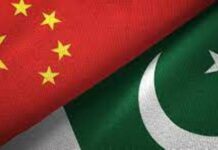BEIJING: “Paukphaw” has been a buzzword this week ahead of Chinese President Xi Jinping’s state visit to Myanmar on Friday and Saturday. Xi’s visit to Myanmar is his first overseas trip in the new year, and is expected to open up a new era of the China-Myanmar fraternal friendship. “Paukphaw,” a Myanmar term that means “fraternal,” has now been widely used to characterize the millenniaold relations between China and Myanmar. The birth of China-Myanmar “Paukphaw” fraternity was legendary. Over the millennia, every generation of the Chinese and Myanmar people has enriched the term with the feats of their times and contributed to the steadfast progress of the bilateral relationship. Today, the comprehensive strategic cooperative partnership between the two brotherly neighbors, which highlights high-level political mutual trust, in-depth economic cooperation, close coordination on international and regional affairs, as well as robust people-to-people exchanges, stands as the most suitable footnote of “Paukphaw.” As good neighbors and friends, China supports Myanmar’s efforts to maintain peace and stability and achieve national development, and safeguard national sovereignty and reject foreign interference. Bilateral economic cooperation has been both dynamic and substantial. For years, China has been Myanmar’s largest trading partner and important source of foreign investment. The latest customs data show that China’s trade with Myanmar expanded by 28.5 percent year on year in 2019 to about 17.71 billion U.S. dollars. Myanmar, a country that has a strong and pressing need in such infrastructure as railroads, ports, electricity and telecommunications to jumpstart its economic takeoff, has been an active and important partner in the China- proposed Belt and Road Initiative (BRI) from the very beginning. The China- Myanmar Economic Corridor (CMEC) and other major cooperation programs like the Kyaukpyu Special Economic Zone have boosted Myanmar’s employment and economic development, and greatly improved the wellbeing of the Myanmar people. According to Myanmar’s income and expenditure report in the 2019-2020 fiscal year, the CMEC, which has linked the under-developed and developed regions and contributed to a better use of the country’s development resources, has fueled domestic transport and tourism services. As a result, the country’s economic growth is expected to exceed 7 percent. China’s practical cooperation with Myanmar has also been mutually beneficial in nature, and the benefits have not been confined to economic categories. Take the China-Myanmar oil and gas pipeline project for example. While China has imported crude oil and natural gas from the Southeast Asian country, the program has channeled 27 million dollars into a host of social-economic assistance programs in the fields of health, education, power, water and disaster relief.



